Muhammed Fansa | Yamen Moghrabi
In the first visit in about 20 years, China received the head of the Syrian regime, Bashar al-Assad, to the sound of songs and dances in the city of Hangzhou in the east of the country, where al-Assad met with the Chinese president, Xi Jinping, and confirmed the “heading east” strategy.
China is one of the countries that defended the Syrian regime in international forums and used its veto several times alongside Russia to abort resolutions condemning it, but without having other prominent roles in helping Damascus economically or militarily, similar to the two prominent allies Russia and Iran, whom al-Assad has visited more than once in recent years.
Huge applause for a modest outcome
Local Syrian newspapers headlined the front page of their publications commenting on al-Assad’s visit to China, with titles that show the impact and great importance of the visit, such as “Summit of the Strategic Relationship,” “Strategic Partnership,” and “A Distinction Point,” while experts believe that China’s goal of the visit was to send “political messages.”
On the official level, the Syrian Foreign Minister, Faisal Mekdad, described the visit as representing a “new leap” in the history of relations between the two countries, basing his explanation of the importance of the visit on the fact that the international situation “has changed a lot, and China’s role has become prominent at various levels.”
Mekdad said that the relations between the two countries are “very developed,” and this visit will be a “new leap” in the history of relations, whether through the support that China provides to Syria or through the support that Syria provides to China through its belief in “one China,” and its support for all the initiatives put forward by China over the past years.
Political “quid pro quo”
The statements during the visit at the political level between the two parties included support for the political orientation of each country, which appeared in the joint final statement after the meeting between al-Assad and Jinping, where the statement stipulated “an exchange of firm support on issues related to the core interests and major concerns of the other side.”
In the statement, the regime supported the principle of “one China,” which represents all of China, considering that Taiwan is an integral part of Chinese territory. It also supported the Chinese position regarding Xinjiang (East Turkestan) and that it is not an issue related to human rights but rather the fight against “terrorism.”
Xinjiang province, where Uighur Muslims live, is the subject of global criticism against China, as UN reports have been issued documenting “grave violations” of human rights committed against the Uighur Muslim minority that amount to “crimes against humanity.”
As for the Chinese side, in the statement, it supported the “measures” taken by the regime’s government in order to “preserve the country’s security and stability” and rejected interference in Syria’s internal affairs, the illegal military presence there, or the plundering of its natural resources illegally, and urged the lifting of the imposed sanctions against the regime, which is consistent with the regime’s narrative in international forums.
Doctor of Political and Economic Studies Salam Kawakibi told Enab Baladi that the trend towards exaggerating the effects of the visit, as well as the trend towards mitigating its effects, is “wrong.” It is certainly not a visit on the sidelines of the Asian Championship, but rather, China announced through it the strengthening of its policy towards the regime.
Although China supports the regime indirectly and votes in its favor in the Security Council, it was “very far” from direct involvement in the Syrian file because, unlike Russia and Iran, it is looking for “returns on its investments” and not just political investments, according to Kawakibi.
The recent tension between China, the West, and America, and the talk about a trade route that will start from India through Saudi Arabia, passing through Israel towards Europe, has caused China to once again encourage talk about the “New Silk Road,” which will pass from Syria through the regime, which Kawakibi described as a “political quid pro quo.”
China aims to strengthen relations with the regime and other countries with anti-Western policies, such as Iran, Venezuela, and Russia.
The Chinese government is adopting a “new diplomatic” position characterized by a challenge to American policies by strengthening relations with countries that the United States has sought to isolate, according to Shaher al-Shaher, an academic at the Faculty of International Studies at the Chinese University of Sun Yat-Sen.
The former professor of the Faculty of Political Science at the University of Damascus based his analysis on the fact that Beijing recently received Venezuelan President Nicolas Maduro, and this visit resulted in the announcement of raising relations between them to the level of a “strategic partnership for resilience.”
Dr. Karam Shaar, director of the Syrian program at the Observatory of Political and Economic Networks, told Enab Baladi that China is waving the “Syrian card” in the face of Western countries, which are trying to isolate the regime and impose sanctions on it if pressure continues on its internal issues such as Taiwan.
Ayman Dasuki, fellow at the Omran Center for Strategic Studies, believes that the Syrian regime is trying to exploit Chinese interest in the Middle East and sees in it a window to reduce the economic pressures of its Russian and Iranian allies and an opportunity to expand “the margin of its political maneuvers.”
|
Beijing wanted the visit to send a message to confirm its growing role in the Middle East and to compete with America, in addition to its desire to diversify its roles from a mediator following the completion of the Saudi-Iranian agreement to engaging in more distant roles, and perhaps also economic roles in order to exploit existing opportunities. Beijing also wanted to obtain strategic locations in Syrian geography, such as ports and crossings, which would help it achieve its vision of the Belt and Road Initiative (BRI), or security roles related to involvement in the region’s security arrangements, from the gate of combating terrorism, that is, the Uighurs present in Syria. Ayman Dasuki – A research fellow at the Omran Center for Strategic Studies |
To break isolation
Al-Assad’s visit to China coincided with the annual meetings of the United Nations General Assembly, where heads of state and foreign ministers of countries attend. While Syria’s representative to the United Nations, Bassam Sabbagh, was present at the meetings, Foreign Minister Mekdad headed to China with the delegation accompanying al-Assad.
With the regime’s continued international isolation for 12 years, during which it did not visit non-Arab countries except Russia and Iran, al-Assad is trying with his trip to China to “assure” that he is capable of establishing strong diplomatic relations with his allies that compensate for the severed relations with the West, according to a report by the Syrian Dialogue Center on September 26.
Al-Assad could request the mediation of China to intervene with Saudi Arabia in order to advance the “wheel of normalization,” which in recent months led the rapprochement efforts between Riyadh and Tehran in light of the emergence of indications of a decline in Arab communication with Damascus, due to the regime’s weak response to Arab demands, according to the report.
Professor of Political and Economic Studies Salam Kawakibi believes that one of the reasons for the importance of this visit is that it could open the doors of Brazil, South Africa, or even India to the regime, given that China is an essential member of the joint BRICS alliance between these countries.
Political economy researcher Joseph Daher agrees that al-Assad’s visit to China is an important step, as the Asian Games were an “appropriate justification” for the timing of the regime’s reintegration into the global diplomatic sphere, encouraged by the recent Arab rapprochement with Damascus and the Syrian regime’s return to the Arab League.
For China, the visit is “largely a symbolic step” and represents part of Beijing’s strategy to act as a “more proactive and assertive leader in the Middle East and to act as a counterweight to US influence,” according to Daher.
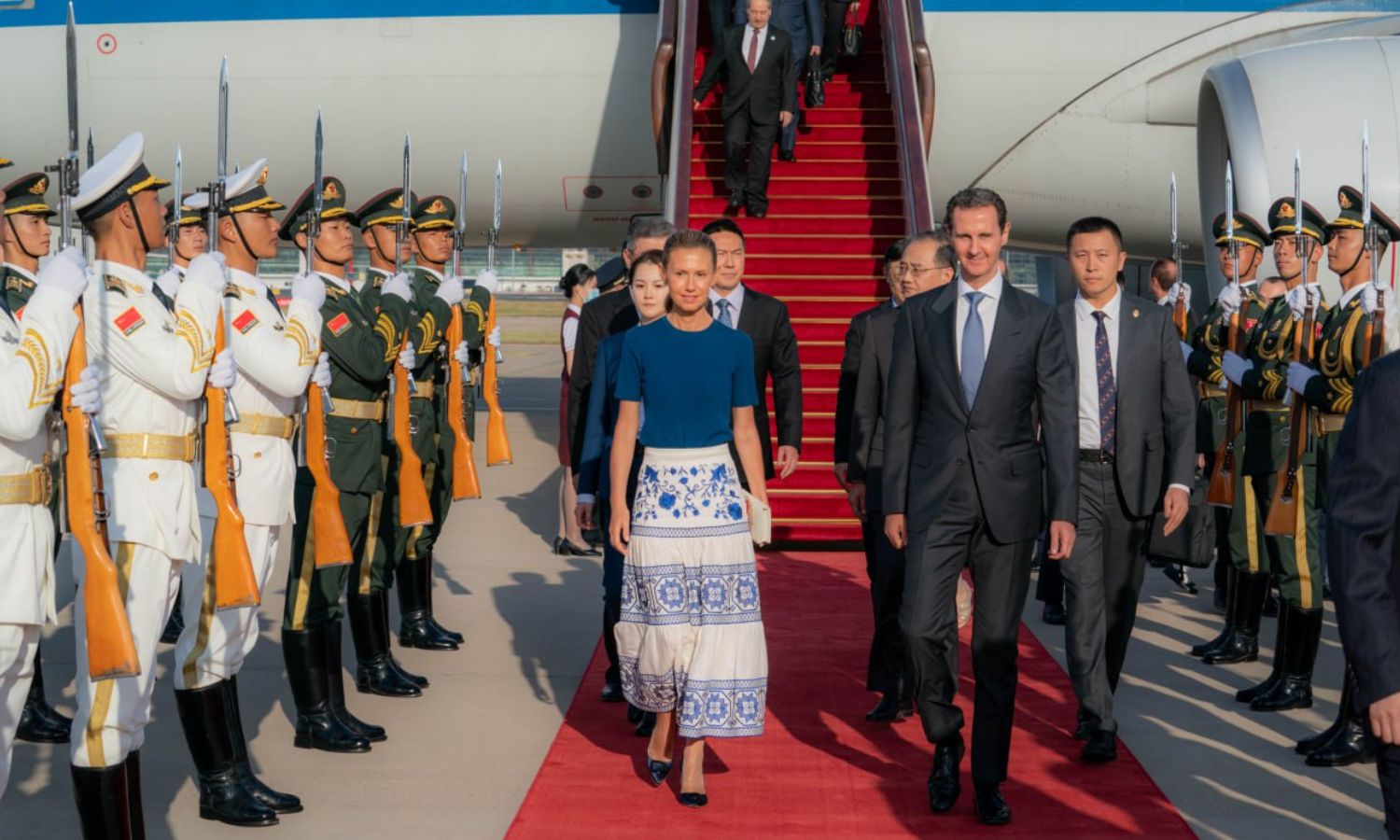
The arrival of the head of the Syrian regime, Bashar al-Assad, and his wife, Asma, at Beijing Airport – September 24, 2023 (SANA)
Economic agreements, what is their importance?
In his statements during his presence in the cities of Hangzhou and Beijing, al-Assad supported China’s initiatives in global development, global security, and global civilization, especially the Belt and Road Initiative (BRI), which he described as aiming to “achieve security and development for all through integration, not through confrontation.”
The signed agreements included a memorandum of understanding on the common context of a cooperation plan within the framework of the Belt and Road Initiative (BRI), an agreement for Syrian-Chinese strategic cooperation, and a joint memorandum of understanding for exchange and cooperation in the field of economic development.
Dr. Shaar, head of the Syrian Program at the Observatory of Political and Economic Networks, had low expectations for the visit due to China’s “past tendency” to make promises and not follow through on them. He cited the example of its investment promises to Iran worth $400 billion in infrastructure in 2021.
Similarly, with regard to Syria, Shaar said that after the announcement of Syria’s accession to the “Belt and Road” initiative, no economic activities were produced.
In January 2022, Syria announced its joining of this project after the visit of Chinese Foreign Minister Wang Yi to Damascus in July 2021.
Before the visit, Shaar expected that clear agreements would be signed with specific projects and announced numbers, but without implementation, which did not happen. Rather, the signed memorandums were “loose” without specifying any real steps towards working on projects.
In the opinion of the economic academic, China has reaffirmed its position by seeking a political settlement in Syria, which “angers” the regime.
The official and local Syrian media did not mention the Chinese President’s talk about “promoting the political settlement of the Syrian issue, in accordance with the principle of Syrian leadership and Syrian ownership,” which was reported by the Chinese Xinhua agency on September 22.
According to Shaar, China has no real desire to invest in Syria due to the lack of stability or political and economic clarity in the country, especially because the nature of China’s investments is linked to infrastructure, which can take many years, up to ten years.
For its part, the Syrian regime hopes to obtain economic support from China in light of the economic crisis that its areas of control are experiencing and to encourage it to enter into reconstruction and “early recovery” agreements that are facing “faltering,” according to a report by the Syrian Dialogue Center.
The regime seeks to take a role within the Belt and Road Initiative (BRI), which was demonstrated by the signing of three cooperation documents, including a memorandum of understanding related to cooperation within the framework of the economic initiative, according to the report, which indicated the inability of the regime’s government to provide anything “substantial” to China in this initiative.
Kasia A. Houghton, researcher at the University of St. Andrews in Scotland, said in an analysis published on the American Monitor website on September 25 that “In China, Syria’s Assad gets political fanfare, but no funding commitments.”
There have been no Chinese-funded projects announced since Syria joined the Belt and Road Initiative (BRI) in January 2022, indicating Beijing does not see Syria as a safe place yet to invest in, according to Houghton.
“In fact, (the visit) it appears that far from being a partnership founded on commitment, this strategic partnership is merely a potential promise of future cooperation on China’s terms.” said Houghton, adding that “If the Sino-Syrian strategic partnership is to be worth more than the paper it is written on, Beijing may need to invest more than just words, and perhaps even more capital, to secure investments and returns in Syria.”
What is the Belt and Road Initiative (BRI)?
China is counting on the Belt and Road Initiative (BRI), which transports Chinese goods to European countries via land and sea via a network of railways that includes the countries of China, India, Armenia, Iran, Iraq, Syria, and Turkey, by land, and through a land-sea network that includes Indonesia and India, all the way to the Suez Canal, then Italy, and from there to the European Union countries.
China announced its project for the first time in 2013, and in conjunction with this project, Beijing worked for years to establish its presence in Africa and Asia by establishing infrastructure, according to the “winner-winner” rule.
According to a study prepared by the Chatham House Research Center, the BRI is an ambitious plan to develop two new trade routes connecting China with the rest of the world.
But it is actually not limited to infrastructure alone, but rather an attempt to develop an expanded and interconnected Chinese market, economic and political development, and create suitable conditions for building a technological economy.
The study writers, Dr Yu Jie, senior research fellow on China, and Jon Wallace, deputy head of news and comment, believe that there are three main motives behind the BRI.
The first and most discussed internationally is China’s rivalry with the US. The vast majority of Chinese international trade passes by sea through the Malacca Strait off the coast of Singapore, which is a major US ally. The initiative is integral to China’s efforts to create its own more secure trade routes.
The second key reason for the initiative is “the legacy of the 2008 financial crisis. China’s government responded to the emergency with a 4 trillion yuan stimulus package, issuing contracts to build railways, bridges, and airports, but saturated the Chinese market in the process.”
The Belt and Road framework provides an alternative market for China’s vast state-owned companies beyond the borders of China, said the study.
Finally, the “BRI is seen as a crucial element in the Chinese government’s efforts to stimulate economies of the country’s central provinces, which historically lag behind richer coastal areas.”
In 2017, the initiative was incorporated into the Chinese Constitution, with the Chinese government describing the initiative as “an attempt to enhance regional connectivity and embrace a brighter future.”
US response, Economic Corridor (IMEC)
With the growing Chinese role that raises concerns in Washington, the latter announced the India-Middle East-Europe Economic Corridor (IMEC) project linking India with markets in the Middle East and Europe, a parallel project starting from India by sea to the Emirates, and from there via railway to Saudi Arabia, then Jordan and Israel, then by sea to Greece, to then continue its way to the EU countries.
The IMEC project, announced by US President Joe Biden, represents a “serious challenge” to Chinese plans, especially with India’s rise as an economic and productive power in the face of its neighbor China and its possession of similar factors in terms of population, infrastructure, and cheap labor.
According to a study published by Mona Hani Mohammed, a researcher from the Department of Political Science at Cairo University, the presence of rising, geographically contiguous, and competing regional powers limits the building of a stable regional security system, especially since these powers are governed by economic considerations, and this affects the type of means and strategies used to achieve its interests.
The study, issued in 2022, indicated that China’s presence allowed smaller countries in the region to escape Indian hegemony and its attempts to dominate them, and Beijing also used the BRI as a non-military means to assert influence in the Eurasian region, including Nepal, Bangladesh, and Sri Lanka.
Ahmed Qasim Hussein, a researcher at the Arab Center for Research and Policy Studies, told Enab Baladi that Washington seeks through the IMEC project to undermine China’s role politically and economically.
Washington signed, with Saudi Arabia, UAE, India, France, Germany, Italy, and the European Union, on the sidelines of the G20 summit held in New Delhi, a memorandum of understanding to establish the India-Middle East-Europe Economic Corridor linking India to the Middle East and Europe.
The corridor includes the construction of railway lines, energy transmission pipelines, and data transmission cables.
The IMEC project, which Biden described as “historic,” is considered an American response to the BRI, which is seen in the West as a geopolitical project with an economic-developmental cover that aims to extend China’s influence across Asia, Africa, and Europe, according to Qasim Hussein.
The US project also aims to establish the Middle East region as an American zone of influence in exchange for China’s attempts to penetrate it, as well as integrating Israel into the Arab region and strengthening India’s position in the face of China.
As important as the American project seems to be aimed at weakening China directly, the director of China in Arabic Center for Studies, Jad Raad, downplays the project as “improvised.”
Raad told Enab Baladi that the project begins in India, the country closest to Russia and China as a partner in the BRICS group more than it is close to Washington, and ends in the Haifa port, and the Indian government has many reasons to stay away from the “American show.”
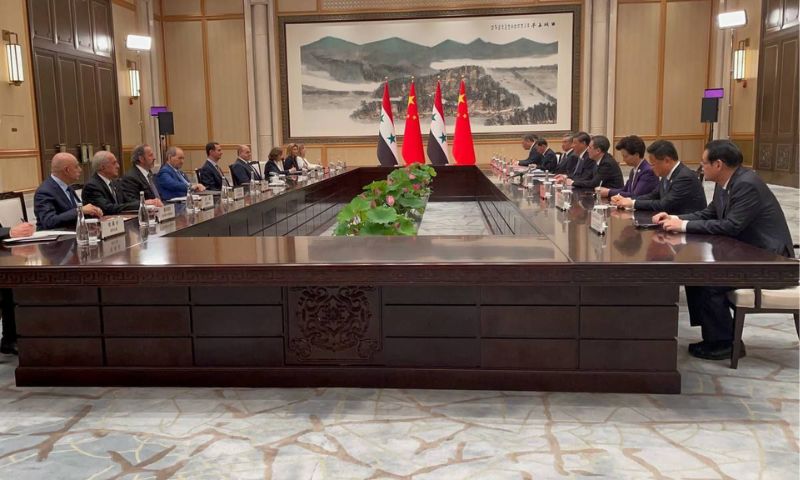
A bilateral meeting between Syrian regime head Bashar al-Assad and Chinese President Xi Jinping in the Chinese city of Hangzhou – September 22, 2023 (Xinhua)
|
The American (IMEC) project seems theoretical, not practical and lacks a realistic approach. It could stir up certain fanaticism that leads to tensions and conflicts, and the Chinese project’s primary purpose is to dispense with sea lanes in order to get rid of any American blackmail. Jad Raad – Director of the China in Arabic Center for Studies |
Conflict or competition?
The India-Middle East-Europe Economic Corridor (IMEC), which was announced by the US on September 10, is geographically similar to China’s Belt and Road Initiative (BRI) and comes within the framework of the economic competition between Beijing and Washington.
In a surprising step, last March, Saudi Arabia announced an agreement to restore its diplomatic relations with Iran, under Chinese sponsorship. Saudi Arabia also discussed with China the establishment of a nuclear plant on its territory, which raised concerns in Washington, according to what was published by The Wall Street Journal on August 25.
In December 2022, Riyadh hosted the Arab-Chinese summit, which was attended by Chinese President Xi Jinping and leaders of the Gulf Cooperation Council countries. The Guardian reported at the time that the Gulf countries were likely to cement ties between China and Saudi Arabia – and deepen alarm in Washington.
The IMEC project, which was announced by US President Joe Biden during the G20 summit in India, reflects his vision of “long-term investments” and the desire to embrace other countries as partners, according to The Washington Post.
Although the general picture suggests a Chinese-American conflict in several areas, the researcher at the Arab Center for Research and Policy Studies, Ahmed Qasim Hussein, believes that talk about the relationship between the two parties revolves around the growing competition in many geostrategic areas for both parties on the economic and military levels and not a conflict.
He added that this rivalry reached its intensity in the South China Sea region, specifically after the escalation between China and Taiwan, and this rivalry resonated in the Middle East region.
In June 2022, the Middle East Council for International Affairs published a study indicating that China does not wish to play security roles in the Arabian Gulf region nor to replace the United States in this file as a body that guarantees the security of the region.
China is the largest trading partner of the Gulf Cooperation Council countries, with an estimated value of $161.4 billion, according to the council, which pointed to the infrastructure projects that China has completed in the region, within the railway sectors in Saudi Arabia and sports stadiums in Qatar, in addition to importing oil and other sectors.
On the other hand, Iraq’s invasion of Kuwait in 1990 represented an opportunity for the United States of America to enter militarily into the Middle East and provide protection to the Gulf states. It established military bases in the Dhahran region in Saudi Arabia and in Bahrain, where the Fifth Fleet is stationed, in addition to the American base in Qatar.
After the disappearance of the “Saddam Hussein threat,” according to the American vision, the Iranian threat arose, the export of the “Islamic Revolution,” and disagreements between the Gulf states and Iran over several other files.
Considering that China does not wish to play a security role as an alternative to Washington, it is trying to balance its relations with the conflicting countries in the region.
According to the study, the Arab Gulf states established economic ties with China, which made the relationship “balanced” for Beijing between Tehran and Arab capitals, and later established comprehensive strategic partnerships with both parties.
Consequently, China is following an opposite path in its relations with the countries of the region from that of Washington, which has explicit hostility with Tehran and more intertwined relations with the Gulf states that China does not have.
China entered the Middle East according to the theory that it followed in many countries of the world, which is “winner-winner,” that is, the common interests of it and the opposing party as well, according to the director of the China in Arabic Center for Studies, Jad Raad.
|
Washington is redefining its security and political role in the region, which has prompted Beijing to develop its relations with the countries of the Arab region within the framework of the Belt and Road Strategy and to work to build strategic partnerships with the Arab Gulf states and develop its military exports with the UAE and Saudi Arabia recently. In addition to China’s attempts to promote itself at the level of developing digital infrastructure in the Gulf region, and in return, China realizes the importance of the Gulf region for energy exports that the Chinese market is thirsty for. Ahmed Qasim Hussein – Research fellow at the Arab Center for Research and Policy Studies |
What is China’s future in Syria?
A 2021 study by the Center for Policy and Operations Research estimated that Chinese companies were responsible for extracting about 12% of Syrian oil production until 2010.
Given the regime’s government’s tendency to diversify the interests of oil companies in the country, the research center suggested that more Chinese investments would appear again as the security situation improves.
Since 2011, Beijing has focused its Middle East strategy on economically low-risk investments in sectors where it believes it has a comparative advantage compared to Iran and Russia, Damascus’s main allies.
Professor of Political and Economic Studies Salam Kawakibi limited the possibility of China’s economic entry into Syria by securing investment in the project in full, away from any Syrian role in the project, in order to avoid corruption in the regime’s government that might prevent it from achieving the returns on this investment.
Kawakibi gave an example of China’s investments in Algeria, where in its projects it relies on sending its workers, engineers, companies, and equipment, while the role of the local party is only to grant the license.
Kawakibi believes that China does not have military or strategic goals for investment in Syria, but it has economic goals and messages that it sends to the West that it is capable of extending its influence to the borders of the Mediterranean.
Political economy researcher Joseph Daher does not expect the visit to achieve any near future investments in Syria at the economic level, based on the promises of the Chinese Foreign Minister, Wang Yi, to “advance relations to a new level” in investments in the Syrian economy during his visit to the country in 2021, which are still not achieved.
On the other hand, in 2017, Chinese companies committed to reconstruction contracts with a total value of two billion dollars, but like other promises to Chinese investment, most of these contracts have not yet been fulfilled, according to expert Joseph Daher.
There are many obstacles and deterrents to China’s investments in Syria, according to Daher, the most important of which is the “miserable state” of the Syrian economy after 12 years of war, Western sanctions, the bad business environment, geopolitical complexity with the presence of Turkish, US, Iranian, and Russian forces on the ground, and economic and political instability.
Dasuki, the researcher fellow at the Omran Center for Strategic Studies, believes that China’s economic role if it enters Syria will be “sectoral,” meaning focusing on what concerns it without engaging in large investments, especially since there are two other “players,” the Russians and the Iranians, who have received the largest investments in the field of oil, gas, seaports, phosphate and communications, and China does not want to clash with them.
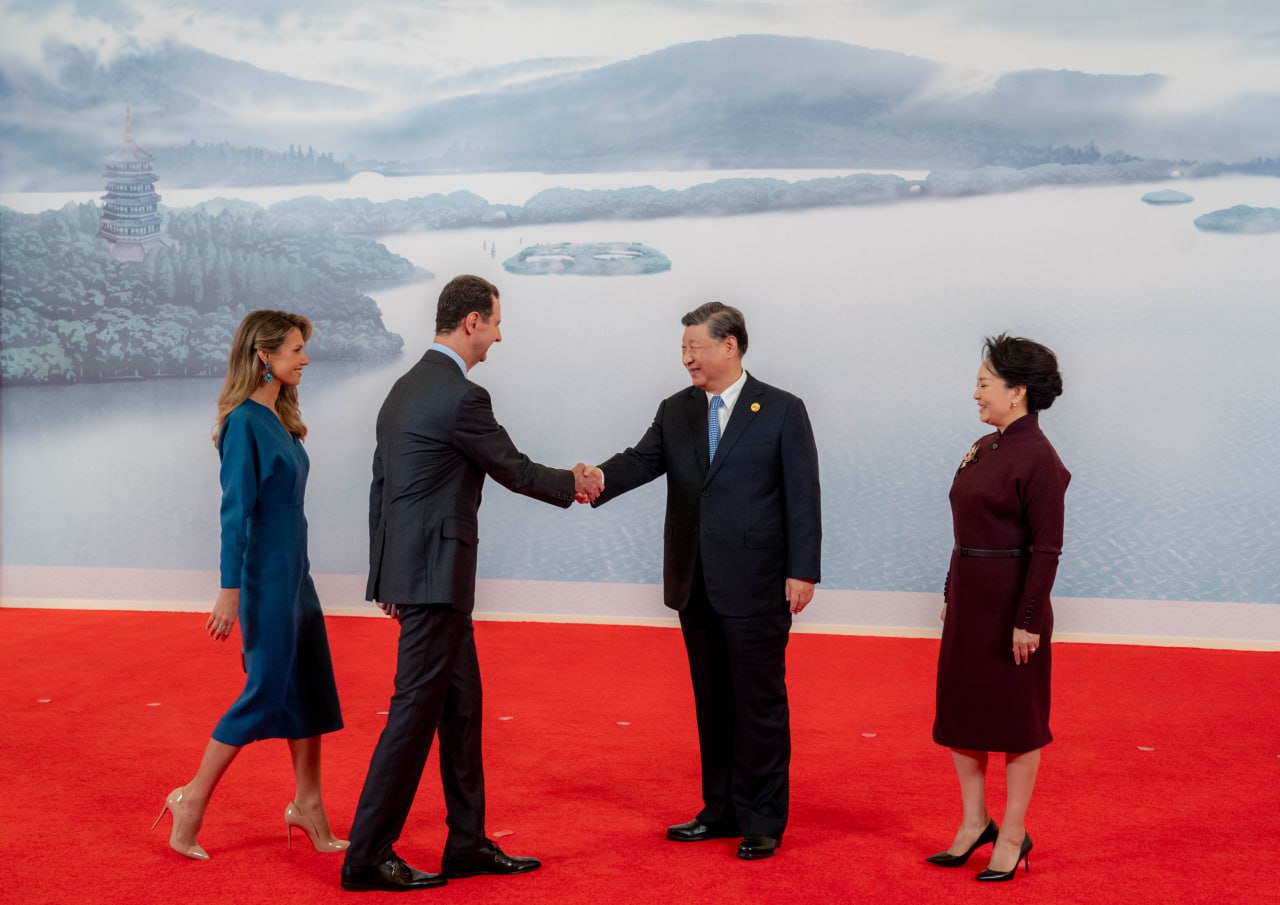
Syrian regime head Bashar al-Assad and his wife attend an official banquet in honor of the heads of delegations invited to the opening ceremony of the Asian Games in the Chinese city of Hangzhou – September 24, 2023 (SANA)
|
The regime bet on openness to the Gulf countries to receive funds, but they were withheld from it, so it requested funds from Russia, which refused and demanded that it pay its debts. As for Iran, in exchange for not paying the debts, it took investments for free, and as for China, it will have a space without competing with Russia or Iran, and it will deal with them in controlling the Syrian economy. Salam Kawakibi – PhD in Political and Economic Studies |
How do Russia and the US view Syrian-Chinese rapprochement?
America’s interest in the Syrian file stems from its interest in the Kurdish file. As for the remaining issues related to Syria, the current US administration has no interest in them, according to the expert in political and economic studies, Dr. Salam Kawakibi.
“The Chinese BRI project (the New Silk Road) is a long-term and far-fetched project, and it is unlikely that there will be any current American moves in response to this road,” Kawakibi says.
Dasuki of the Omran Center for Strategic Studies agrees with this opinion, who believes that the Chinese role in Syria will not bother Washington much as long as it has strong cards and it does not represent strategic importance for the US.
While Russia may see the Chinese role as a “competition” to it, and it does not look with comfort at China’s successes in the Middle East, especially the Saudi-Iranian agreement and marketing itself as an international player in an internationally important geography.
Meanwhile, Russia is still unable, so far, to achieve a qualitative breakthrough in the Middle East files, whether in the Syrian-Turkish reconciliation or the region’s security arrangements, according to Dasuki.
Political economy researcher Joseph Daher believes that Russia will consider strengthening Syrian-Chinese relations a “positive matter” because it needs other actors to invest in Syria to improve the economic situation and add progress to Damascus’s global normalization.
On the other hand, the visit will have a negative impact on the United States on the basis that it strengthens China’s influence in the Middle East.
“Anything that could strengthen the Syrian economy, even partially, will be against the framework of the maximum pressure policy that Washington is exercising on the regime through its sanctions,” Daher concluded.
if you think the article contain wrong information or you have additional details Send Correction
النسخة العربية من المقال
-
Follow us :
Most viewed
- Al-Sharaa names new Syrian government
- Intentions for popular resistance amid Israeli escalation in southern Syria
- Kurdish Protection Units: Key point of contention between Damascus and SDF
- Syrians look forward to visiting graves of "martyrs" on Eid morning
- Eid clothing prices rise in Idlib: Predominantly priced in dollars












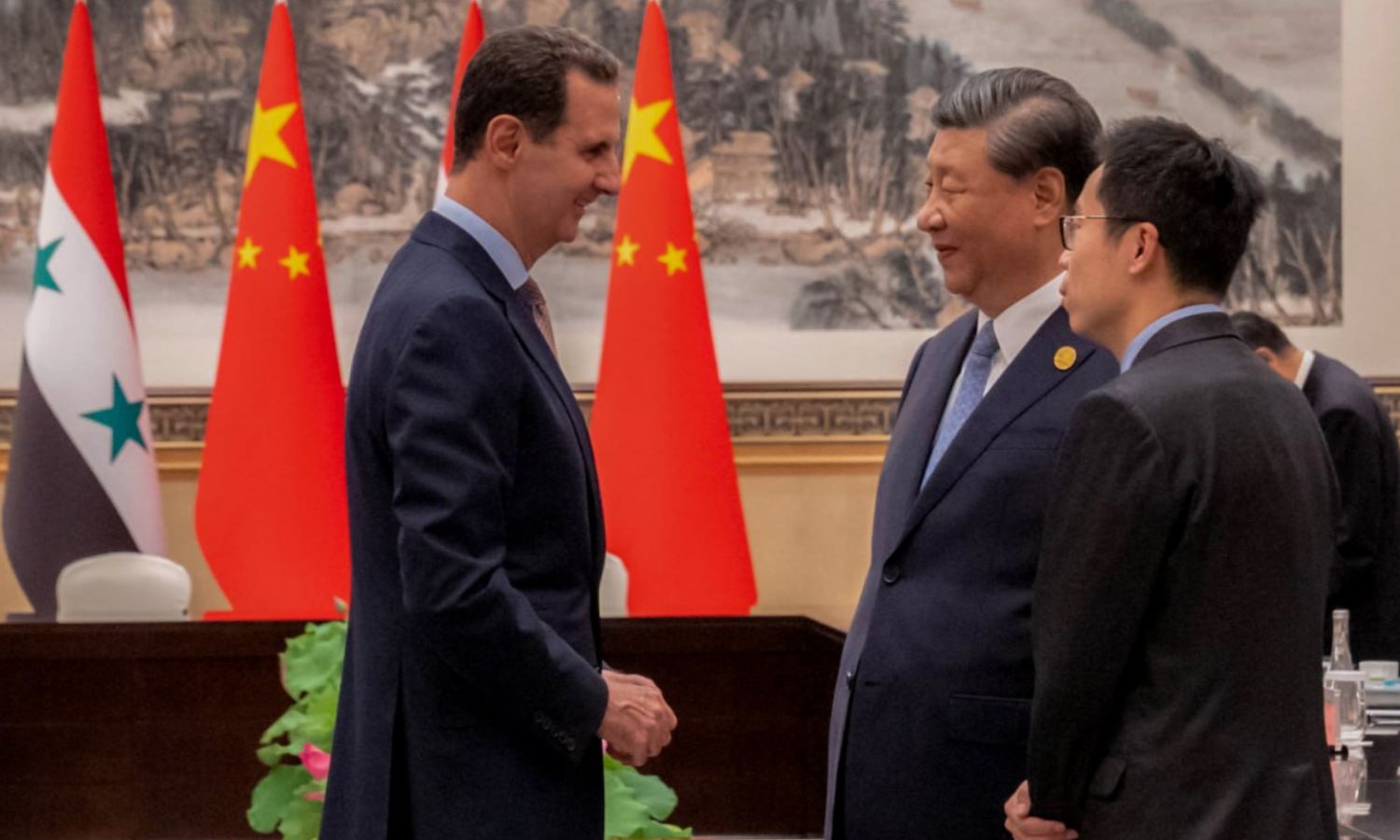
 A bilateral meeting between Syrian regime President Bashar al-Assad and Chinese President Xi Jinping in the Chinese city of Hangzhou - September 22, 2023 (SANA)
A bilateral meeting between Syrian regime President Bashar al-Assad and Chinese President Xi Jinping in the Chinese city of Hangzhou - September 22, 2023 (SANA)





 A
A
A
A
A
A
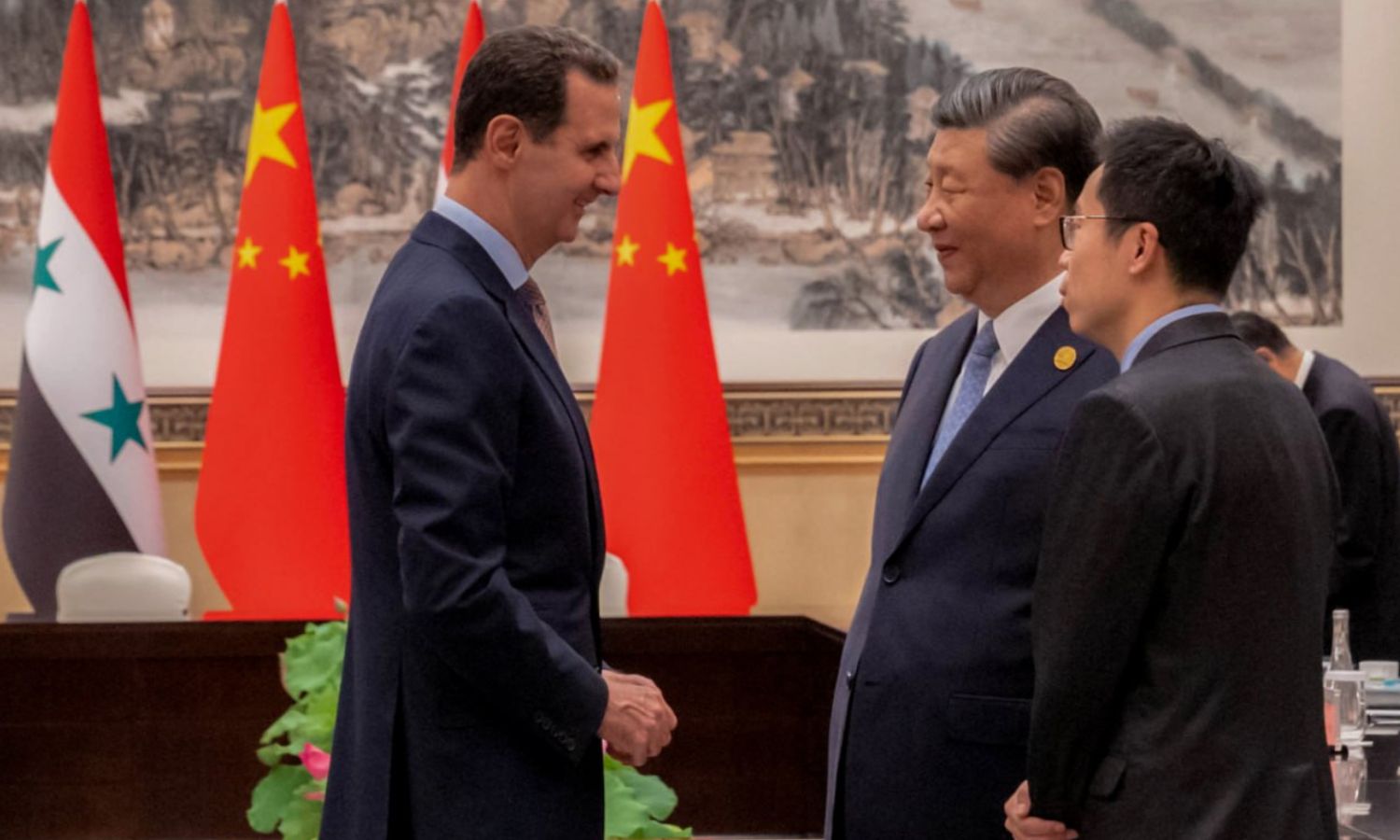







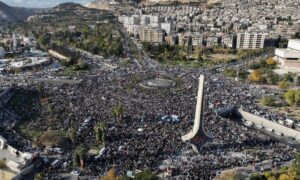
 More In-Depth
More In-Depth